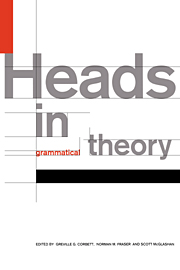Book contents
- Frontmatter
- Contents
- List of contributors
- 1 Introduction
- 2 The head of Russian numeral expressions
- 3 The phonology of heads in Haruai
- 4 Patterns of headedness
- 5 Head-hunting: on the trail of the nominal Janus
- 6 The headedness of noun phrases: slaying the nominal hydra
- 7 Head- versus dependent-marking: the case of the clause
- 8 Heads in discourse: structural versus functional centricity
- 9 Heads in Head-driven Phrase Structure Grammar
- 10 Heads and lexical semantics
- 11 Heads, parsing and word-order universals
- 12 Do we have heads in our minds?
- 13 Heads, bases and functors
- References
- Index
11 - Heads, parsing and word-order universals
Published online by Cambridge University Press: 23 February 2010
- Frontmatter
- Contents
- List of contributors
- 1 Introduction
- 2 The head of Russian numeral expressions
- 3 The phonology of heads in Haruai
- 4 Patterns of headedness
- 5 Head-hunting: on the trail of the nominal Janus
- 6 The headedness of noun phrases: slaying the nominal hydra
- 7 Head- versus dependent-marking: the case of the clause
- 8 Heads in discourse: structural versus functional centricity
- 9 Heads in Head-driven Phrase Structure Grammar
- 10 Heads and lexical semantics
- 11 Heads, parsing and word-order universals
- 12 Do we have heads in our minds?
- 13 Heads, bases and functors
- References
- Index
Summary
Introduction
Two key issues in the discussion of heads are: how is ‘head’ to be defined, and are there clear linguistic generalizations that provide evidence for this notion? The debate between Hudson and Zwicky in the Journal of Linguistics (Hudson, 1987; Zwicky, 1985) illustrates the difficulties inherent in answering the first question. There is disagreement over which grammatical properties define, or correlate with, heads, and hence over the precise set of categories that are supposedly instances of this generalization. With regard to the second question, one grammatical area that has been cited as relevant is word order (see, for example, Zwicky, 1985: 10–11). It is often proposed that heads are consistently positioned either before or after non-heads within their respective phrasal categories. Vennemann (1974) formulates a Natural Serialization Principle for this regularity, and reformulates it in Vennemann (1984) in terms of the typological distinction between ‘pre-specifying’ (that is, modifier before head) and ‘post-specifying’ (head before modifier) languages.
This chapter will consider what word-order universals as currently formulated suggest about the notion ‘head of phrase’. I will argue, with Hudson, that there is a significant generalization here, but that it is not ultimately the kind of generalization he proposes. Indeed, the notion ‘head’ can probably be dispensed with altogether, as a property of Universal Grammar. Instead, I believe the underlying generalization involves a principle of parsing: the relevant categories provide unique ‘Mother Node Construction’. They enable the language user to recognize the existence and nature of the syntactic grouping of words to which the word and category in question belong, and so inform the listener about abstract syntactic structure on-line.
- Type
- Chapter
- Information
- Heads in Grammatical Theory , pp. 231 - 265Publisher: Cambridge University PressPrint publication year: 1993
- 1
- Cited by



